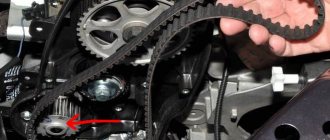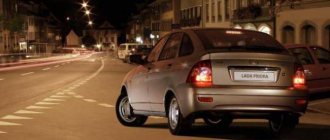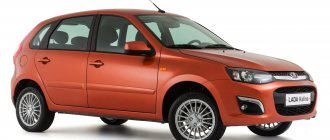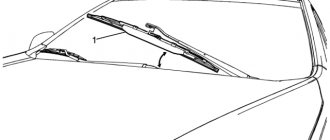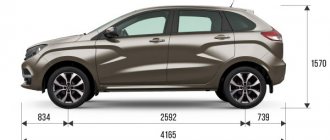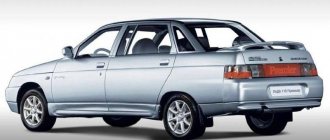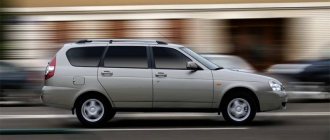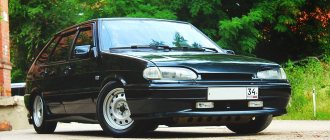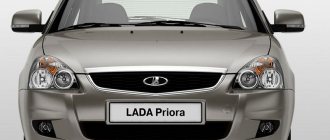In the last month of summer in 2012, on the podium of the AvtoVAZ automobile show in Moscow, the 2nd generation Lada Kalina hatchback was presented to the general public. If we compare it with its successor, the car was able to retain recognizable features, but it became noticeably better in appearance and interior, as well as from the technical side.
The following year, or more precisely on May 16, 2013, the company launched the production of Kalina 2, and in the summer buyers could already purchase it. It’s quite funny, but in order to promote its model, the Russian company chose a slightly slang expression: “Lada Kalina – Complete stuffing!” The entire Lada model range.
The appearance of the new car has noticeably changed, as the main elements of the design work of modern cars from Europe have been introduced into it. The bow of Kalina now looks much larger and brighter, as car enthusiasts are a little tired of the dull appearance of the previous generation. The presence of power lines of the hood has appeared, which taper towards the radiator grille and create the sensation of an expanding trapezoid. Also, all this gives the car’s exterior some sporty and aggressive characteristics.
Exterior
The appearance of the second generation Lada Kalina remained recognizable, but received a more harmonious, attractive and modern finish. The nose of the car is decorated with a hood with characteristic ribs, and there are also stylish lighting equipment with a darkened background and a massive front bumper with an air intake “mouth” and chrome decor (top trim levels also have fog lights).
The head optics flow smoothly into the narrow strip of the radiator grille. The bumper installed in front is of a relief type with a massive air intake in the center and has fog lights along the edge, which are covered with chrome “eyelashes”. True, we must admit that an air intake of this size does not fit perfectly with the overall design of the Lada Kalina 2.
You immediately notice the streamlined shape of a brand new car. They are not at all similar to the angular shapes that were present in previously produced VAZ models. Thanks to the smoothed body corners, the aerodynamic component has been improved, which has made it possible to reduce the noise of headwinds and make travel at high speeds more comfortable. If you look at the side of the car, you can see the presence of a sloping hood, a slightly sloping roof towards the rear, large door openings and large wheel arches.
All this together allows the hatchback to have a light and moderately dynamic silhouette. The fact that there are no stampings on the side body parts is made up for by the presence of door trims, which give the appearance of the car some relief against the background of the overall smoothing of the appearance. The wheel arches turned out to be a little swollen, and thanks to the high ground clearance of the hatchback, its solidity is felt.
The rear of the Lada Kalina 2 is compact and has beautiful lights, a neat luggage compartment lid and a small bumper with a plastic cover at the bottom, which serves as a protective option. As a result, the domestic new product looks quite good and fresh, and in terms of design it matches foreign cars.
The trunk door is decorated with restyled unique optics, which, with its lower element, connects the sidewall and the upper part of the rear bumper. The new rear bumper has a pair of reflective strips integrated into it on the sides.
the volume and overall dimensions of the body are described
When buying a car, for most people, not only technical characteristics are important, but also trunk volume. Moreover, with other similar parameters, it is the trunk volume that often turns out to be the decisive factor when choosing a specific car.
In 2013, the release of a new generation Lada Kalina was announced. And on May 16 of the same year, the first car with a hatchback body type rolled off the assembly line.
The car body has not undergone significant changes; the chassis has remained the same (the suspension has been slightly improved). As for the trunk volume of the Lada Kalina hatchback, according to the specifications, it is 240-550 liters.
What does this mean?
That with the rear seats installed, it is 240 liters, and if they are folded down, it will increase to 550. This volume is significantly less than the volume of the trunk of a Lada with a station wagon body (remember, this parameter was respectively 355/670 liters).
The trunk dimensions of the Lada Kalina hatchback are as follows:
- width – 947 mm;
- depth – 644 mm;
- height – 492 mm.
With the rear seats folded, the depth increases to 1319 mm, and if the trunk is left open, it can carry cargo up to 1277 mm in size.
As you can see, for a small family this car is even suitable for traveling, and if you only use it for commuting to work and visiting, then the relatively lower cost (compared to the same “station wagon”) makes it a more profitable option for purchase.
myhatch.me
Interior
The second generation salon is distinguished by the presence of modern design and high ergonomic indicators. Also, the presence of a massive steering wheel with 3 spokes immediately catches your eye, behind which lies an informative instrument panel, which is represented by two shallow “wells” and a modest monochrome screen of the on-board computer. To the left of the steering wheel, a place was allocated for the light-amplification control unit, and under it, an inconspicuous button was installed, which is responsible for opening the luggage compartment (this decision can be called one of the most important miscalculations in terms of ergonomics).
The center console consists mainly of a color touch display of the multimedia system, which is covered with a small visor on top. A control panel for the music system was installed under it, and under it there are already 3 rotating “washers” of the air conditioning system. In general, getting into the hatchback is quite comfortable, partly due to the presence of wide-opening doors and a large doorway.
Thanks to large mirrors along with a low window sill, the car provides good visibility. You can also notice the presence of a box for small items, which was placed on a console installed in the center. We increased the volume of the glove compartment with a shelf for small items and a pen holder.
There are a pair of cup holders and a pair of niches on the lining of the floor tunnel, a handbrake lining with a folding cup holder for passengers sitting in the back, a speed change “prompt” on the LCD display of the instrument panel, a multimedia system with the Hands free option, an electric drive for the recirculation flap, new interior paint options, as well as new luggage compartment shelf supports to increase the loading opening.
The climate system, which was developed specifically for the Lada Kalina 2, looks interesting. It has become quite effective than on previous cars, and it is much quieter. There is also an “AUTO” option (not on all modifications), which can distribute air flows, change the fan speed and control the air dampers automatically.
The driver only needs to set the temperature inside the car. For the future, the company wants to equip the multimedia system with a GSM/GLONASS geonavigation module. Many systems have been introduced that are designed to increase the level of comfort in the cabin. For example, there is a steering column adjustment for tilt, electric power steering, air filtration that enters the cabin, an instrument cluster with on-board computer options, an automatic headlight and power unit system.
In general, the Kalina interior itself was assembled mainly from “hard” plastic, and the softest part is the steering wheel. In principle, there are no complaints about the assembly itself, but there are still some shortcomings that the factory could not cope with. In some places you can notice joints, and the screws are exposed and not covered with anything.
If you look at the car from the point of view of a budget hatchback, then it has comfortable seats in the front, where there is soft filling and a wide range of settings, and the amount of free space allows even tall people to sit comfortably. The sofa installed at the back is quite comfortable for a couple of people, and if particularly necessary it can accommodate three, but there will only be enough free space for two.
The legs do not rest against the backs of the seats installed in front, and there is also enough free space above the head. The luggage compartment of the 2nd generation Lada Kalina is about 260 liters. In shape, it is quite comfortable, although the wheel arches “eat up” a little free space. The rear sofa, if necessary, can be folded entirely or in parts, which will result in about 550 liters of usable volume.
For all versions of cars, a full-fledged spare wheel, a jack and a wheel wrench are included. The luggage compartment lid is equipped with an electric lock, which can only be opened using a button located to the left of the steering wheel, or in the standard way - with a key.
Specifications
Power unit
The 2nd generation Lada Kalina hatchback will come with one of three power units operating on gasoline. These are 1.6-liter four-cylinder “aspirated” engines. The most basic is considered to be an engine with an 8-valve system (VAZ-11186), which has a lightweight connecting rod and piston group from Federal Mogul. It can produce about 87 horses at 5,100 rpm.
The connecting link between the motor and the wheels is a 5-speed manual gearbox with a cable drive, or a 4-range hydromechanical “automatic” Jatco. However, no matter what kind of gearbox there is, the car only has a front-wheel drive layout.
The car reaches the first hundred in 12.2-14.2 seconds, and the maximum speed is 161-168 km/h (where the higher value is with a manual transmission). In the combined cycle, the engine consumes about 7 - 7.7 liters of fuel per hundred kilometers.
Between them is the presence of the VAZ-21126, a 16-valve gas distribution mechanism with four cylinders arranged in a row. It can already develop 98 horsepower at 5,600 rpm. This engine is synchronized only with an automatic gearbox, which allows it to reach a speed mark of 100 km/h in 13.1 seconds, and the maximum speed is already at 175 km/h. Based on average consumption, the power unit consumes 7.6 liters per 100 km.
Next comes the most powerful 16-valve VAZ-21127, which was equipped with the latest electronic fuel supply system, the electronics were reconfigured and dynamic supercharging was installed. All this allows it to produce 106 horsepower at 5,800 rpm. From the very beginning, for such a power unit, only a manual gearbox was provided, which enabled the Lada Kalina hatchback of the 2nd generation to pass the 100 km/h mark in 11 seconds, and the top speed of which is about 181 km/h. Moreover, engine consumption is not huge, only about 6.7 liters per 100 km in medium loads.
Chassis
The Lada Kalina 2 was built on the VAZ 2190 base, which was subjected to serious improvements.
The front axle uses an independent design with McPherson struts, and the rear axle has a semi-independent design with coil springs. The steering of the car is carried out using a built-in electric power steering wheel made in Korea. The braking system is represented by ventilated discs of the brake system at the front, and there are drum mechanisms on the rear wheels. Specifications
| Modifications | engine's type | Engine capacity | Power | Transmission | Acceleration up to 100 km/h, sec. | Maximum speed km/h |
| Lada Kalina Hatchback 1.6 MT | Petrol | 1596 cm³ | 87 hp | Mechanical 5st. | 12.2 | 168 |
| Lada Kalina Hatchback 1.6 AT | Petrol | 1596 cm³ | 87 hp | Automatic 4 speed | 14.2 | 161 |
| Lada Kalina Hatchback 1.6 AT | Petrol | 1596 cm³ | 98 hp | Automatic 4 speed | 13.1 | 175 |
| Lada Kalina Hatchback 1.6 MT | Petrol | 1596 cm³ | 106 hp | Mechanical 5st. | 11.0 | 181 |
| Lada Kalina Hatchback 1.6 AMT | Petrol | 1596 cm³ | 106 hp | Robotic 5st. | 12.9 | 175 |
Safety
Security systems include the presence of:
- Immobilizer.
Passive safety includes:
- Driver airbag;
- ISOFIX child seat mounting.
Active safety and suspension include the presence of:
- Anti-lock braking system with electronic brake assist (ABS+BAS);
- An electronic system that can distribute braking forces (EBD).
In modern conditions, the production of any car is simply unacceptable without the introduction of modern technical means to ensure the proper level of safety. This can also be applied to the Lada Kalina 2, which already comes standard with the cheapest model:
- Driver's airbag;
- ISOFIX child seat anchors;
- Three-point inertia seat belts.
The most complete set boasts the presence of:
- Airbags for the front passenger;
- Seat belt pretensioners;
- Anti-lock braking system (ABS) with brake assist (BAS);
- Electronic Stability Control (ESC);
- Traction control system (TCS).
The hatchback also features daytime running lights in the headlights, a high-strength steel body frame, a driver's seat belt warning light, side safety bars, L-shaped rear headrests that can be folded to improve visibility, and muffling capabilities. multimedia system when the car is moving.
Test drive Lada Kalina - Universal version (Kalina 1.4; 1.6)
“Lada Kalina” with a new body
Sales of the Lada Kalina station wagon have begun. The car received not only a new body. The chassis of the vehicle has changed somewhat, and the list of additional equipment has expanded.
AvtoVAZ CONSTRUCTORS did not change the overall dimensions of the car - for the new version of Kalina they are the same as for the usual sedan.
Due to the fact that the length of the car has remained unchanged, the trunk volume (the main thing for which station wagons are valued), let’s say, is not impressive. Still, 350 liters (when loaded up to the window line) is not the best figure by modern standards. Competitors that are similar in size have more impressive cargo compartment capacity. Moreover, in this parameter, the Kalina station wagon is not much ahead of the hatchback, whose trunk volume is 235 liters, but is inferior to the sedan (400 liters). At the same time, the carrying capacity of any modification of the Kalina, regardless of body type, is 475 kg.
Of course, the rear seats can be folded (in a ratio of 1:3), and then the trunk volume will increase to 650 liters. However, on other compact class station wagons this figure comes close and sometimes exceeds 1,000 hp.
However, two or three travel bags will fit here comfortably. Another thing is that it is not very convenient to load luggage - the lower edge of the trunk door opening is located quite high. But for securing things in the cargo compartment there are several metal loops.
Watch your back!
TO GET acquainted with the car, Togliatti residents laid out a driving route through the whole of Kazakhstan - from north to south. In the vicinity of Almaty, the heat is 30 degrees, and in the cabin of the Kalina, pleasant cool air blows from the deflectors. Conventional air conditioners are no longer uncommon on domestic cars. They are installed on “Samara”, and “Priors”, and on “Volga”. But climate control is still a novelty for our automakers. “Lada Kalina” in the “Lux” configuration is actually the first production Russian car equipped with this device. True, the algorithm for its operation is not entirely clear - the deflectors alternately emits arctic cold and desert heat.
Climate control, soft seats, good ergonomics... It would seem, what more could you want? However, after a long trip in the second row of seats, my back ached all night. The point is not at all in shaking and not in the quality of Kazakh roads (they, by the way, are quite decent, with the exception of the 150-kilometer stretch between Balkhash and Alma-Ata). Just so that when folding out the rear sofa you don’t “lose” the seat belt buckles, plastic latches are built into the back of the chair. They are located exactly opposite the lower back - you want to lean back in a chair, but hard plastic digs into your back.
With the exception of this fastener, there are no other comments regarding comfort in the passenger seats. Thanks to the high body, there is quite a lot of headroom. Despite the relatively small external dimensions, the rear passengers will not feel cramped, even if a tall driver or passenger is sitting in front: there is enough legroom.
old friend
FOR THE TEST, the organizers prepared cars equipped with an 81-horsepower 1.6-liter engine. This motor has been installed on the Kalina from the very beginning of its production and is already well known. You can't expect any new impressions from him.
However, it feels like a station wagon with this engine accelerates a little slower than a sedan or hatchback. The reason lies in the new settings (this engine meets Euro-3 requirements, and before we drove Kalinas with a Euro-2 engine), as well as in the increased weight of the car. After all, a station wagon is 30 kg heavier than a hatchback and sedan...
Due to the increased weight of the car, the designers had to use stiffer springs and shock absorbers. This had a beneficial effect on the handling of the Kalina: the car became more collected and rolls less in turns. True, on a rough road passengers shake a little more than in other modifications. Another thing would be to change the settings of the steering mechanism so that the steering wheel would not be so “empty” and uninformative - and one could say that on the road the Lada Kalina is practically in no way inferior to its foreign counterparts...
There is progress in the quality of car assembly. The Kalina I drove last fall in Karelia was annoying with the glove box constantly opening on bumps and vibrating mirrors. Now such sins have not been observed with the car. However, by the end of our run, a dozen and a half “crickets” started up in the station wagon’s interior...
350 liters is not the most impressive trunk volume for a compact class station wagon.
| Brief technical characteristics of “Lada Kalina” station wagon | ||
| 1.4 | 1.6 | |
| Overall dimensions, cm | 404x170x150 | |
| Curb weight, kg | 1.110 | |
| Engine | 4-cyl., 16-valve, 1,390 cc. cm | 4-cyl., 8-valve, 1,596 cc. cm |
| Power | 90 hp at 5.250 rpm | 81 hp at 5,200 rpm |
| Torque | 127 Nm at 4,200-4,800 rpm | 120 Nm at 2,500-2,900 rpm |
| Transmission | 5-speed, mechanical | |
| type of drive | front | |
| Maximum speed, km/h | 165 | 160 |
| Acceleration 0-100 km/h, s | 12,2 | 13,5 |
| Average fuel consumption, l/100 km | 7 | 7,8 |
| Fuel capacity, l | 50 | |
Author Kirill SAZONOV Edition Klaxon No. 10 2008 Photo photo of the author and AvtoVAZ
www.motorpage.ru
Options and prices
On the market of the Russian Federation, the 2nd generation Lada Kalina car will be sold at three levels of equipment - “Standard”, “Norma” and “Lux”. The most starting configuration “Standard” will be priced from 447,500 rubles. It will have a fairly small list of equipment. There will only be an electric power steering wheel, 14-inch steel wheels, a front airbag for the driver, an immobilizer, a pair of electric windows and ISOFIX technology for child seats.
There will also be three-point inertia seat belts, a side light, an instrument cluster with options for an on-board computer and an electronic clock, a separate rear-mounted seat, fabric upholstery, lighting for the glove box and trunk, and a tool that includes a jack and a combination wheel wrench.
The steering column can be adjusted according to the angle of inclination, which can also be said about the adjustable seat belts of the seats installed in front (in height). There will also be an air filter that enters the cabin, athermal glass, a full-size spare wheel and body paint in the body color (pastel or metallized).
The “Norma” package will already have central locking, a standard audio system, air conditioning, electric windows for the rear doors, a front airbag for the front passenger, ABS, BAS, EBD and an alarm system. There will also be a mirror in the sun visor, a cigarette lighter with an ashtray, heated front seats, and an electrically operated tailgate lock with remote control and control from the cabin. The price of this modification will start from 481,500 rubles.
The top-end “Lux” package will come with “full stuffing”, which will have a full-fledged multimedia system with a screen that supports touch input, a stability control system, heated seats installed in front, rain and light sensors, electric heated front glass, fog headlights, exterior mirrors with electrical settings and heating option and alloy wheels.
There will also be an indication of the temperature outside, a container for glasses, a system for safe parking of the car, rear-view mirrors painted to match the body color, door handles painted in the body color, black door frames and moldings. Prices for the top version start at 547,800 rubles.
The important thing is that the basic version already has an airbag for the driver.
More advanced modifications have side inflatable protective curtains, which can be purchased as a separate option. Prices and options
| Equipment | Price | Engine | Box | Drive unit |
| 1.6 (87 hp) Standard MT | 447 500 | gasoline 1.6 (87 hp) | mechanics (5) | front |
| 1.6 (87 hp) Norm MT | 481 500 | gasoline 1.6 (87 hp) | mechanics (5) | front |
| 1.6 (106 hp) AMT norm | 513 400 | gasoline 1.6 (106 hp) | robot (5) | front |
| 1.6 (106 hp) Norm MT | 519 200 | gasoline 1.6 (106 hp) | mechanics (5) | front |
| 1.6 (106 hp) Lux MT | 547 800 | gasoline 1.6 (106 hp) | mechanics (5) | front |
| 1.6 (98 hp) AT norm | 564 200 | gasoline 1.6 (98 hp) | automatic (4) | front |
| 1.6 (106 hp) Lux AMT | 567 800 | gasoline 1.6 (106 hp) | robot (5) | front |
Lada Granta
The most popular version of the Grant today is the sedan. The liftback has also become a good seller, but it is still far from being a sedan. The VAZ 2190 is designed for 4 passengers, according to the documents it looks like a B-class car, but after considering the dimensions, you can safely classify it as a C-class.
Being a successor of the “Kalina” traditions, the sedan was even assembled on its platform and borrowed a lot of things from Kalina: body, chassis, interior. On the other hand, it is a different car with a different character, larger cargo compartment, redesigned design, etc. The trunk has been increased to 500 liters.
Here are the standard body dimensions of the Lada Grant.
Lada Granta body dimensions
As you can see, the dimensions of this VAZ model are 22 cm longer than those of the Kalina, but 7 cm shorter than the “Samarov” modifications.
Now other characteristics in more detail:
- The radiator grille has received a new corporate style, now resembling a Volga rook, which is held in place by a powerful molding. This grille cools the engine compartment more effectively, as it is equipped with large “nostrils”;
- The bumper is much softer than the VAZ ones and is painted in body color on some car trim levels;
- The general lines of the hood and trunk roof are slightly raised;
- The front optics have received more enlarged outlines, and in the basic version the cars are also equipped with daytime side light.
As for the trim levels, the new sedan can be purchased in 3 versions. The coolest is the Lux, equipped with a 98-horsepower engine and featuring a completely different level of interior equipment.
Among the features of the Granta body, one can highlight the good quality of the assembly and good quality of materials. The body parts are connected to each other using high-tech automated German welding. This allowed domestic producers to reach a completely different level.
We also highlight the good quality of painting and resistance to anti-corrosion treatment. Both of these processes are also carried out on German-made automated lines with excellent precision.
The modified body geometry gave the new Russian car a stylish, aspirational lines. This had a beneficial effect not only on the exterior, but also made it possible to significantly reduce the AED resistance. Now this coefficient is 0.36, which is more than 6 percent less than the base model. In addition, the pointed hood is less harmful to pedestrians, experts say.
Important functions are performed by overhangs:
- The Granta's rear overhang has been extended by 15 cm. In turn, this makes the interior even more spacious than before;
- The front overhang is designed in such a way as to reduce the thermal load on the engine and its environment.
As for other body differences:
- The underbody was specially designed for the new Russian car. Special metal sheets with special hardening and double-sided galvanization are a good solution that significantly increases service life;
- As for quality of life, in this particular case the indicator is increased by 12 percent when compared with Kalina;
- The weight of the car was reduced by as much as 40 kg, which could not but affect the handling. Now it has become much easier to maneuver in city tight rows, it is more convenient to take turns;
- It has become easier to install an additional roof rack, since the manufacturer has provided good, strong fastenings on top of the door seals.
Unfortunately, Granta did not lose the traditional VAZ “sores”:
- It is inconvenient to adjust the side mirrors. But this is not necessary, since they provide quite good visibility;
- On the other hand, short drivers will have poor visibility of the road due to the raised lines of the hood and trunk.
Advantages and disadvantages
Pros of the car
- Comfortable car;
- Acceptable build quality;
- Modern and quite stylish appearance of the hatchback;
- There is a choice between power units;
- Increased engine power;
- More convenient location of sensors and scales;
- An airbag is present even in the basic configuration;
- There is a reliable suspension, which has an increased resource;
- Improved aerodynamic component of the car;
- Good ride height;
- Comfortable interior;
- Pretty good front soft seats;
- Lots of free space;
- Availability of a touch display;
- Good top-end equipment;
- Quite low consumption of power units;
- Reinforced body.
Cons of the car
- Even in the basic configuration the price of the car is very high;
- Small luggage compartment volume;
- Fairly light steering wheel with no feedback from the road surface;
- Noisy and rather outdated 8-valve power unit;
- Hydraulic headlight adjustment;
- There is no sensor on the prior panel that shows the coolant temperature;
- Still poor build quality;
- Appearance is not for everyone;
- Weak engines;
- Low level of security;
- The back row is only comfortable for two passengers; a third will be extremely uncomfortable.
Features of the Cross modification
When considering the entire list of modifications of the LADA Kalina, one cannot ignore the outstanding VAZ project - the Cross version. This car is built on the basis of a station wagon, but has an impressive list of additions
Here the developers have placed significant emphasis on the ground clearance, which is an enviable 208 mm. The perimeter of the body is decorated with decorative linings, which simultaneously perform a protective function. On small off-road terrain the car behaves quite confidently. The developers did not forget to use enhanced protection for the engine sump and transmission unit housing.
Kalina Cross allows the owner to install wheels with a larger diameter, which also benefits both ground clearance and the exterior as a whole.
Let's sum it up
After the release of the Russian-made hatchback Lada Kalina of the 2nd generation, it is clear that AvtoVAZ does not want to stand still, but wants to move forward, gradually competing with other cars imported even from European countries. The overall appearance of the car has become more fresh, it looks nice, especially the front, youthful, but at the same time stylish. The hood received small stampings, and the side part, or rather the doors, have a characteristic molding.
The aft part has a rather characteristic appearance for the company. Moreover, there is a large door with a convenient opening, which makes loading and unloading cargo easier. The interior is of course far from perfect; there is budget-type plastic, although it does not look the cheapest. The instrument panel is of a standard type, although for some reason it lacks a coolant temperature sensor, a strange solution.
But there is a convenient small touch screen display, which is very convenient to operate. The front seats, as for a budget model, are well padded and soft. The back row can comfortably accommodate only two people; the third will be able to sit down, but will experience discomfort. There is enough free space in the car.
But I was not pleased with the luggage compartment, since it has very little usable space. But you can fold the rear seat backs, which increases the volume of the luggage compartment. The car comes with stronger power units, which are not the most powerful, but cope well with their direct responsibilities.
I was pleasantly surprised by the low consumption of these engines, which will be a good plus, especially when driving in urban areas. The car already has an airbag for the driver as standard, which is very good. The level of safety is certainly far from Volvo, but the fact that AvtoVAZ is gradually growing in this direction is encouraging.
There are various systems that will make you feel confident in a hatchback. It is clear that the Russian automobile company is not sitting idly by, but is striving to be competitive.
We advise you to read the article: History of AvtoVAZ - LADA cars
Dimensions
Compared to previous VAZ models, the Lada Kalina has increased in size, which has a positive effect on the space in the cabin and the amount of luggage space in the trunk; the dimensions are noticeably larger. Note that the height, as well as the width, of the car remained unchanged, but the length increased noticeably.
It is these dimensions that now amount to 3.89 m. Let us recall that the width is 1.7 m and the length is 1.5 m. These are the dimensions of the car body. Another significant advantage of the Kalina is the ability to be equipped with an automatic transmission unit. The owners immediately appreciated this move, which allows the nimble Lada Kalina to “tolerate” city traffic jams well.
Let's touch on the body. For the practical “Russian”, the developers have provided an all-metal body frame.
The vehicle's curb weight reaches 1160 kg, and with full regulatory load it is 1560 kg. Moreover, we have already reported the dimensions of the body above, and they are not small.
We know the dimensions of the body, it’s time to talk about the dimensions of the luggage compartment Kalina now offers the owner a number of advantages. If you fold the back rows, the useful volume of space for placing cargo “grows” to 550 liters. Here, practical drivers will appreciate this solution, since they often have to transport items whose dimensions exceed the parameters of the trunk itself.
The station wagon modification has also grown significantly in size. The manufacturer has additionally equipped the roof of this body version with roof rails, which allows the owner to install an external luggage compartment for transporting large luggage.
The length of the station wagon exceeds 4 meters, which is longer in comparison with a hatchback or the same sedan. The width of the version remains unchanged - 1.7 m, which is also true for the height - 1.5 m.
Separately, we should touch upon the trunk of the station wagon, which has no competitors in the model line of all LADA Kalinas. Folding the backrests of the stern seats allows you to “increase” the volume of usable space to an incredible 670 liters for this class.
The fuel tank on the station wagon has been migrated from the sedan, which confirms the identical volume, capable of holding a maximum of 50 liters.
new-lada.ru
Lada Kalina 2 photos
Read further:
Lifan Celliya
FAW V5 car
FAW V2
FAW Besturn B50
FAW Besturn B70
